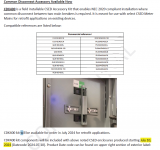kkyyllee
Member
- Location
- california
- Occupation
- building inspector
Good morning, my AHJ has received a request if this "common disconnect accessory kit" would be accepted to meet the requirements of the 2020 NEC 230.71B. Would you consider this to be a
2. Panelboards with a main service disconnecting means in each panelboard enclosure
You could operate each disconnect independently once the dead front is removed. This doesn't appear to meet the intent to me.
2. Panelboards with a main service disconnecting means in each panelboard enclosure
You could operate each disconnect independently once the dead front is removed. This doesn't appear to meet the intent to me.

